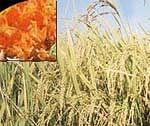
"We are trying to provide legal protection to the vanishing red rice variety, grown in the state for centuries, by bringing it under the ambit of the Protection of Plant Varieties and Farmers' Rights Act 2001," R.P. Kaushik, director of the rice research centre at CSK HP Krishi Vishvavidyalaya, an agricultural university based in Palampur. said.
At present, most of the red rice is grown in around 1,000 hectares on the banks of the Pabbar, a tributary of the Yamuna river, in Chhohara Valley in upper Shimla. It is also cultivated in some stretches of Kullu and Kangra districts.
Red rice can be grown in flooded fields where many varieties would rot. Apart from that, agriculture experts are keen to conserve all traditional crop strains that can be used in case the more widely cultivated varieties develop a disease they cannot cope with.
However, red rice production is declining in recent years as most farmers in the state have turned to lucrative cash crops.
Kaushik said legal protection to the rice variety would also protect the rights of the farmers and enable them and others to market the product around the world.
"If the red rice is brought under the ambit of the act, it would protect the rights of the farmers in respect of their contribution towards conserving, improving and making available plant genetic resources for the development of new plant varieties," he said.
Under the act, a plant breeder wanting to use the farmers' varieties to derive another will have to first seek the permission of the farmers. "With the registration, due benefits could be extended to the local farmers," Kaushik said.
Added Shiv Singh, a farmer from Chirgaon in Shimla district: "We have been planting the red rice for decades. Now, its cultivation has declined in the region due to availability of lucrative cash crops. But we are still cultivating it because of its religious and cultural relevance."
According to Singh, red rice now sells for Rs.50-70 a kilogram in the market.
Kaushik attributed the decline in red rice production to the Green Revolution.
"During the Green Revolution, most of the traditional varieties of the crops were wiped out. Some of the farmers in remote areas are still growing traditional crops because of their medicinal and religious importance and red rice is one of them," he said.
The variety is also grown in Kerala, Tamil Nadu, Maharashtra and Uttar Pradesh. But in the hills, it is grown in a totally organic manner.
The university is also trying to get the red rice registered under the Geographical Indications (GI) of Goods (Registration and Protection) Act , 1999.
"The registration of the red rice under the GI Act would enable the farmers and others in marketing their product around the world," Kaushik said.
"The certification of the product by a department of the central government will stamp the genuineness and origin of the product. This will, of course, help boost its exports too. The ultimate gainer will be the growers."
The GI registration is a community patent in which instead of an individual, the entire community of producers and other stakeholders of a particular area are benefited.